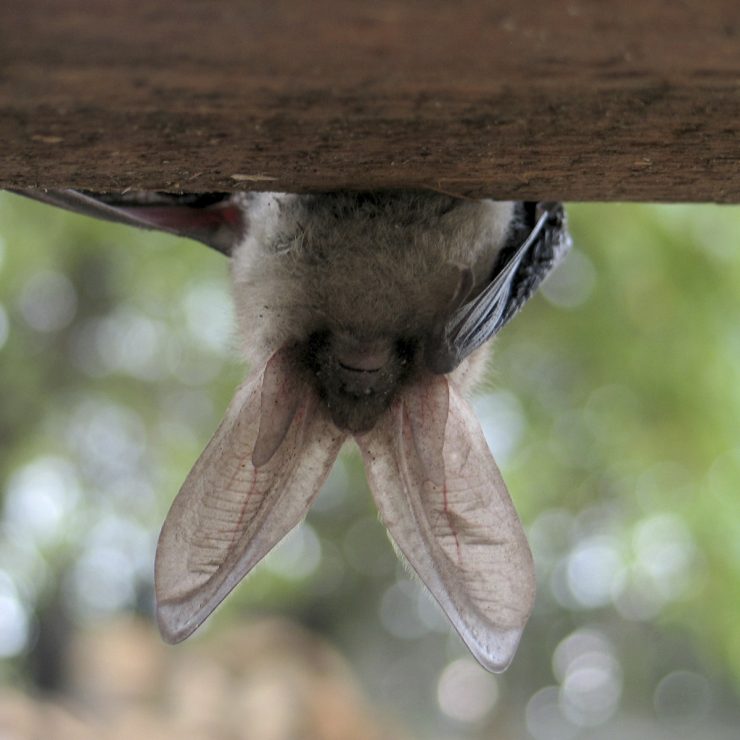by Andrew Der
What do bats with White-nose Syndrome (WNS) have in common with construction projects? Some found out the hard way when proposing clearing of forest that could be home to these WNS infected and federally protected, bats. With recent new regulatory criteria, the good news now for the development industry is not to worry too much about it in most of Maryland.
According to the U. S. Fish and Wildlife Service (FWS), WNS had gradually rendered the Northern Long-Eared Bat (NLEB) species threatened, affording them interim protection measures last year when particular regulatory approvals for construction work are triggered.
So, what is really going on? WNS is a potentially lethal disease caused by a white fungus that grows around bat muzzles during hibernation. First documented in 2006-2007, WNS has spread across the bat populations in the eastern United States and Canada producing a wake of odd bat behavior.
Early FWS initiatives to propose the first restrictions to construction activity were initially viewed by some in the development industry as a technically unsubstantiated regulatory over-reaction that failed to follow mandatory public interest notification processes.
At that time, many construction projects needing a joint U. S. Army Corps of Engineers/Maryland Department of the Environment Section 404 and Tidal/Nontidal Wetlands and Waterways Permit, or any other authorization triggering federal species coordination, were going to potentially need additional screening and time of year construction restrictions.
This potentially included bat habitat field surveys, even if hundreds of miles away from known habitat – and could have also retroactively applied to an already permitted project if construction impacts not yet occurred.
Yikes.
In response to the panicked regulated construction industry, the FWS can be commended for reconsidering their initial approach leading to what became the interim April guidance (declaring it a threatened species under the Endangered Species Act Interim 4(d) Rule), which most in the industry could live with. The interim guidance specified that only projects with forest clearing over an acre west of the Chesapeake Bay were subject to potential review from the FWS Chesapeake Bay field office in Annapolis. If under an acre of forest impact was expected, then no FWS review would be needed if the forest cleared was in: urban woodlots in industrial and commercially developed areas or high density residential areas; apple orchards; tree nurseries; pine plantations; and Christmas tree farms. And if any permanent tree clearing was done outside of the period of April 15 to August 30, then no restrictions applied.
While one could initiate the screening process themselves online with a follow-up to FWS field office staff if a triggering event occurs, terms such as “urban woodlots in industrial and commercially developed areas or high density residential areas” are still subject to human interpretation and technical judgment.
In January 2016 the FWS released its final 4(d) rule for the NLEB species– which further eased the on-the-ground regulatory burden. Although agencies are still refining the implications of the final rule, the short version is that construction activities can proceed unrestricted in locations outside of the known NLEB habitat locations, which covers most of Maryland. Currently only Garrett, Allegany, and Washington Counties in Maryland and New Castle County, Delaware are known to have NLEB species habitat.
So, where does that leave a project actually in one of these counties, or in any another area where NLEB species are newly discovered? That too will be vetted through FWS consultation but for now tree removal is prohibited: within 0.25 miles of hibernating habitat (caves); when known to be a maternity roost nest; or if trees are within 150 feet of such roost trees June 1 through July 31. Hazard tree removal for the protection of human life and property is allowed.
Most significant to the regulated public is neither landowners or permit applicants need to conduct surveys to determine the bat’s presence on the property. Agencies such as the Corps and FWS will rely on data and assessment efforts from the states’ natural heritage database for regulatory guidance as well as to interpret some of the numerous ongoing debates and subjective issues.
Stay tuned – same bat time, same bat channel.
